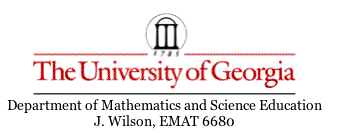
Roxanne Kerry

Roxanne
Kerry
I chose for my writeup #4 to be about problem 6:
Take any triangle. Construct a triangle connecting the three midpoints of the sides. This is called the MEDIAL triangle. It is similar to the original triangle and one-fourth of its area. Construct (the centroid) G, (the orthocenter) H, (the circumcenter) C, and (the incenter) I for this new triangle. Compare to G, H, C, and I in the original triangle.
To begin this exploration, I tried a few different types of examples to show that the medial triangle is in fact, similar to the original triangle and one fourth of its area for all types of triangles. Shown below, I explored this on the Geometers' Sketchpad for an acute, obtuse, and right triangle to confirm this works in all cases. If I did an activity exploring medial triangles in one of my future classrooms, I would likely show my students that these properties of the medial triangle hold for an acute triangle, and have them check to see if they work for any type of triangle.
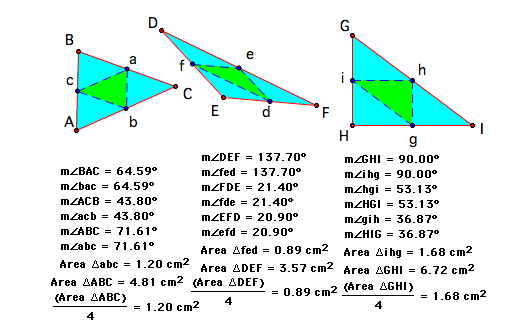
As
we can see in the above example, the corresponding angles for each
pair of triangles are the same and the area of the medial triangles
is one fourth the area of the original triangles in each case. Now
that we have that information, we can explore the rest of the problem
using any general triangle. I will choose to further my exploration
using an acute triangle.
By construction, we can see that the centroid of the original triangle is in fact the same as the centroid! This makes a lot of sense when one considers the actual definition of the centroid and how it is constructed. The centroid is the point in which the three medians of the triangle meet one another. Since the medial triangle is constructed from the three midpoints of the triangle, it intuitively makes sense for the medians of the original triangles to pass through the midpoints of the medial triangle. For a rough sketch at a proof of this, one can rely on the properties we confirmed earlier about the medial triangles. Since it is similar to the original triangle, we can conclude that the midpoints of the medial triangle lie along the median lines of the original triangle.
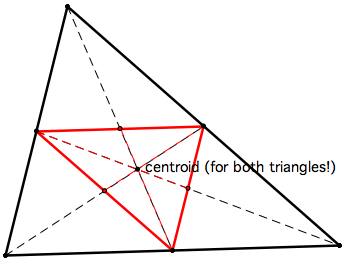
Now
we move on and consider the orthocenter of the two triangles. After
construction (see below) one can see that these are not located in
the same place as the centroid was; however each of the two points
seem to lie in the same place on the each of the two triangles.
Since these two triangles are similar, this is straightforward. In
fact, if you measure the distances from the vertices to the
orthocenter of the triangles, the ratios are the same when comparing
the original triangle to the medial triangle, as shown in my picture.
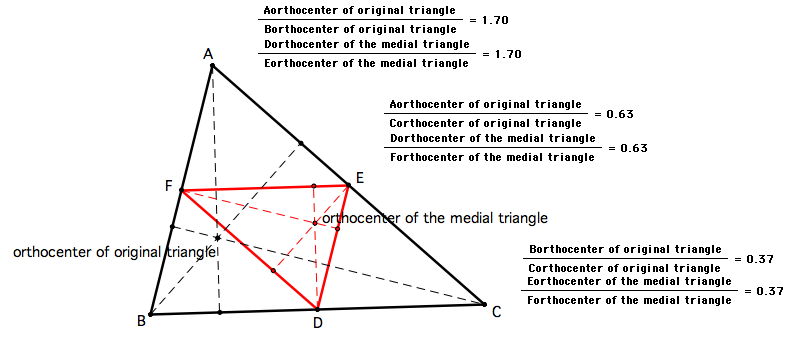
When
exploring the circumcenter of the triangles, one can also come up
with some interesting proportions between the relationship of the
original triangle and the medial triangle. The relationships formed
in the above exploration of the proportions in the orthocenter would
obviously hold in this case for the circumcenter, since by
definition, the lengths of the segments formed from the vertices to
the circumcenter are the same lengths. Interestingly enough though,
if you construct a quadrilateral from the three vertices and the
circumcenter for both the original and the medial triangle, both this
area and the complement of this area have the same ratio to one
another as the original triangle does to the medial triangle! For
the original triangle ABC, the quadrilateral formed by ABC and the
circumcenter is exactly four times the size of the quadrilateral
formed by the vertices of the medial triangle and its circumcenter.
This also holds for the complement of each of these regions. If you
recall from the first information we were given about the medial
triangles, the ratio of the area of the original triangle to the area
of the medial triangle is also four to one. (See illustration below)
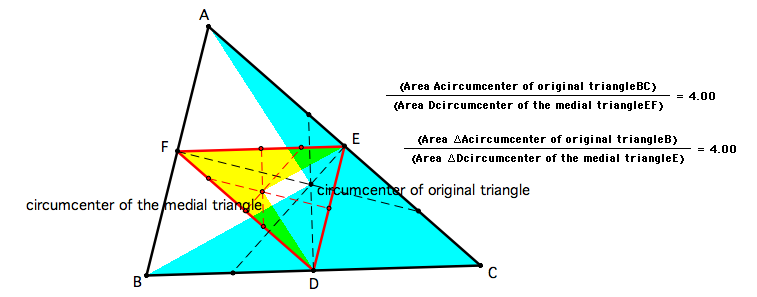
Lastly,
we go into an exploration of the incenters of the two related
triangles. The results end up being the same as the exploration of
the circumcenters! Once the incenters of both triangles are found,
one can create a quadrilateral formed by the vertices and incenter of
the original triangle and also a quadrilateral formed by the vertices
and incenter of the medial triangle. The ratio of the two resulting
quadrilaterals is four to one, just like the ratio of the two
triangles. Similarly, the ratio of the complements of the two
regions is also four to one, as illustrated in the diagram below.
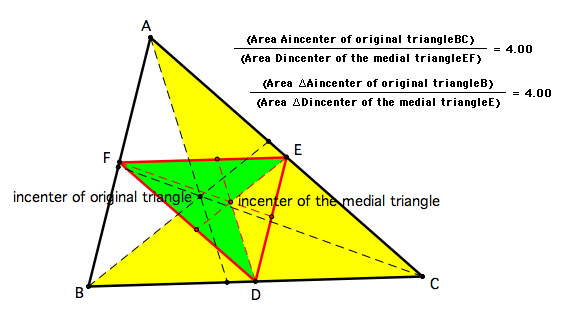
In
conclusion, one can see that the medial triangle is special in that
it shares many of the same properties of the original triangle. The
common ratio of the two areas stays the same for many different
regions using the same points of the two similar triangles. In a
high school classroom, this could be a useful activity to combine
several different concepts at the same time in a unique and
interesting way. The students could investigate with this activity
how to find the centroid, orthocenter, circumcenter, and the incenter
of triangles and also see how certain properties of similar triangles
are related to one another. Some partitions of the similar triangles
have the same ratios as the triangles do, and for other properties of
a triangle, there are even more relationships between the two.